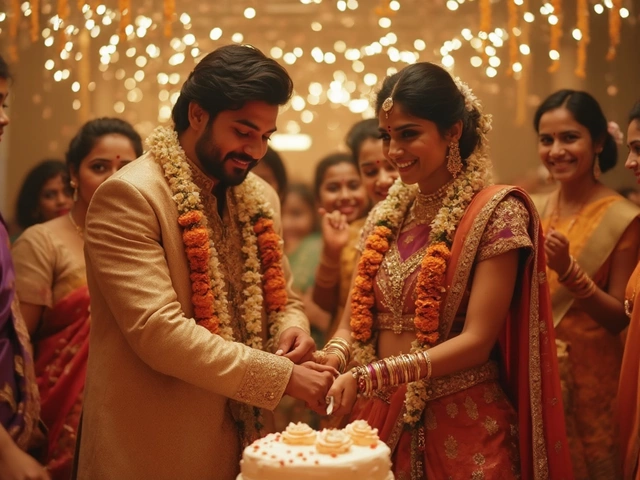
Money talk gets awkward, especially if you have champagne taste and a sparkling Pinterest board. You’re probably wondering: who’s supposed to pay for your wedding dress? Your parents? You? Your partner? Or are you on your own?
Old-school rules say the bride’s family foots the bill. But, like a lot of wedding traditions, that’s starting to change. A lot of people are splitting costs differently or covering their own dress—especially if they want more control over what they wear. If your parents are offering, awesome. If not, you’re not alone. According to a recent survey by The Knot, almost half of brides now buy their own dress, either totally or with a bit of help.
Most couples these days have conversations early, usually right after engagement. It’s way less stressful to ask, "Hey, what’s everyone comfortable chipping in?" before you start browsing boutiques. Trust me, it’ll save you from loving a gown that’s way out of reach. And sometimes—surprise!—different family members or the groom even want to spoil the bride with the dress as their special gift.
If you want your dream look but money’s tight, plenty of smart options help you get glam without debt. Renting, buying pre-loved, or hitting a sale can save serious cash. And nobody’s going to check the price tag walking down the aisle.
- How Wedding Dress Costs Were Handled in the Past
- What Most Couples Do About Dress Payments Now
- Navigating Family and Money Conversations
- Smart Ways to Afford Your Dream Dress
- Modern Wedding Dress Etiquette—What Really Matters
How Wedding Dress Costs Were Handled in the Past
Back in the day, you’d see a simple rule: the bride’s family pays for the wedding dress. It was just expected. This comes from old traditions where the bride’s parents covered most of the wedding costs—kind of like a “thanks for marrying my daughter” gesture. In some places, this even stretched to the bride’s family paying for the whole party, flowers, and her accessories.
Let’s get specific. In the 1950s in America, almost every etiquette guide spelled out the same wedding bill breakdown. The bride’s family handled her dress, veil, and beauty expenses. Groom’s side took care of the honeymoon and sometimes bought his tux. This “old rules” split was so common that you’d see actual breakdowns in magazines:
| Item | Payer (1950s & before) |
|---|---|
| Wedding Dress & Veil | Bride’s Family |
| Bride’s Accessories & Hair | Bride’s Family |
| Reception | Bride’s Family |
| Groom’s & Groomsmen’s Attire | Groom & His Family |
| Honeymoon | Groom |
It’s wild, but in some cultures, it was even stricter. In parts of Italy and Greece, for example, a bride’s parents saw the wedding dress payments as part of a dowry. You really didn’t question it—it was a family duty and a big point of pride.
But if this sounds kind of old-fashioned, you’re not wrong. By the 1980s, lots of parents were still paying, but more brides started wanting a say in the style. That set off way more conversations (and sometimes arguments) about budgets and who really gets the final decision.
Now that wedding costs can get huge—an average dress in the U.S. is over $1,800, according to a 2024 WeddingWire report—fewer families just hand over a blank check like they used to. But understanding where these habits come from makes all the new ways people pay feel a bit less intimidating.
What Most Couples Do About Dress Payments Now
Forget the days when only the bride's parents pulled out their wallets for the wedding dress payments. Right now, things look a lot different—and way more flexible. In 2024, about 49% of brides reported paying for their own wedding dress, often using their savings or including it in a wider couples' wedding budget. Only around 36% said their parents covered the whole dress, and some split the bill with family or their partner.
Here’s how the payments tend to shake out now:
- The Bride Pays: Most common. Brides save up, use a credit card, or budget from work checks.
- Parents Help Out: Sometimes just the bride's parents, but these days, both families might chip in.
- Partners Contribute: Some couples see it as a shared wedding cost, so the dress comes from the larger wedding fund.
- Gifted Dresses: Both family members and partners sometimes surprise the bride by covering the whole cost—rare, but it happens!
Take a look at recent numbers from The Knot’s 2024 Wedding Study:
| Who Pays for Dress | Percentage |
|---|---|
| Bride herself | 49% |
| Bride's Parents | 36% |
| Both Families | 8% |
| Partner | 6% |
| Other (Friend, Sibling, etc.) | 1% |
If you want to avoid stress or drama, talk budgets early—even if it feels awkward. People aren't mind readers, so sorting out who pays for what makes everything easier. Lots of couples just slot the dress in with flowers, catering, and the cake as another line in the joint wedding spreadsheet. And if you’re mixing families or traditions, splitting the cost can be a good way to keep things fair.
Bottom line: There’s no single “right” way. Just what works best for you and the people supporting your big day.

Navigating Family and Money Conversations
Talking about money with family can make anyone squirm, especially when it’s about who’s paying for a wedding dress. Nobody jumps at asking, “So…are you covering this?” But getting clear early keeps things smooth later on. Traditionally, the bride's parents paid the full cost, but times have changed—a 2023 Zola survey found 45% of couples either paid for the dress themselves or shared the cost with family.
If you’re not sure where to start, try framing the convo as a team discussion instead of an expectation. For example, “I want your input on the dress budget” usually gets a better reaction than “How much are you giving me?” It’s also smart to ask what folks are comfortable spending before falling in love with a $3,000 designer gown. Remember, even family members who want to help have their own budgets and limits.
Here’s a simple plan to keep things honest and stress-free:
- Find a relaxed time to chat—maybe over dinner or during a casual phone call.
- Share rough numbers. Bring sample dress prices so everyone has realistic expectations.
- Be honest about your wishlist and what matters to you most. Maybe it’s the dress, not shoes or accessories.
- If extra family—stepparents, grandparents, or siblings—want to chip in, write it down so details don’t get fuzzy later.
- Avoid guilt trips if money is tight. There’s always a creative solution.
Some families split wedding costs across categories, not just the dress. Check out this snapshot of what people typically pay for:
| Wedding Item | Most Common Payer | Percent of Couples |
|---|---|---|
| Wedding Dress | Bride/Her Family | 56% |
| Reception Venue | Bride’s Family | 45% |
| Photography | Couple Themselves | 55% |
| Catering | Bride’s Family | 38% |
| Honeymoon | Couple Themselves | 74% |
Every family’s setup is different, but having a plan saves emotions and wallets from surprises. Most important—don’t see money talks as taking the magic out of shopping; see it as making your day less stressful! If all else fails, remember: the wedding dress payments don’t make the marriage; your choices and love do.
Smart Ways to Afford Your Dream Dress
The price tags on bridal gowns can be wild. The average wedding dress in the U.S. costs about $1,900, but some go way higher, and others are much less. You have more flexibility than you think to land your ideal dress without blowing your whole budget.
First off, be honest about your number. Figure out your whole wedding budget, and decide how much you want to put toward your dress. Treat it like any other big purchase: shop around and stick to your limits. Here’s what actually helps:
- Shop Sample Sales: A lot of bridal shops clear out sample dresses a couple of times a year. These are usually the floor models. Prices can be up to 75% off, so you could score a $2,000 gown for just $500.
- Check Out Pre-Loved Gowns: Websites like Stillwhite and Nearly Newlywed have tons of gorgeous, gently-worn designer dresses. Sometimes the previous bride just changed her mind, so the dress was never even worn.
- Consider Renting: No rule says you have to keep your dress forever. Sites like Rent the Runway or local boutiques let you rent a gown for a fraction of the retail price.
- Look for Trunk Shows: Brides who want the latest designs without maxing out their cards should look at trunk shows. You’ll often get a deal or a free veil if you book at the event.
- Tweak a Simpler Dress: Rather than springing for all the extras—like beading or lace—start with a plainer gown and have a tailor add custom touches. Custom doesn’t always mean expensive; simple base gowns plus a wow-factor accessory can add up to something unique.
Some people also turn to family and friends for help. There’s no shame in crowdsourcing or pooling resources if it helps you relax and enjoy the search.
Here’s a quick breakdown of how brides are actually affording their dresses, according to a 2024 wedding industry study:
| How Brides Pay | Percentage (%) |
|---|---|
| Bride Alone | 46 |
| Bride's Parents | 24 |
| Parents & Bride Split | 18 |
| Other (Partner, Family Friends, etc.) | 12 |
If the dress of your dreams doesn’t fit the budget, don’t stress. There are beautiful options at every price point—and honestly, nobody remembers the exact dress cost when they see you glowing at the altar.

Modern Wedding Dress Etiquette—What Really Matters
If you’ve found yourself lost in old advice on who should cover your wedding dress, you’re not the only one. These days, the old rules don’t always fit real budgets or modern families. The big shift? Etiquette is much more about respect and clear conversations, way less about sticking 100% to what grandma did.
If you want a solid answer, here it is: whoever has the means, and whoever wants to help, usually ends up paying. Sometimes it’s a split, sometimes it’s all on you. What’s changed is the pressure—don’t let anyone guilt-trip you into debt or drama. Clear, upfront talks set the right vibe and expectations. The best etiquette has always come down to honesty.
Some couples and families get creative. For example, maybe a grandma or sister contributes as a special gift. Or, sometimes the wedding dress payments come from a joint wedding fund that both partners manage together—which makes sense if you’re already sharing other costs, like the cake or venue.
“It’s less about who pays and more about making thoughtful choices as a team—nobody remembers the old rulebook anymore,” says wedding planner Jove Meyer in Brides Magazine.
The big takeaway: talk early, and keep it simple. Don't wait until the boutique appointment to ask who’s pitching in.
Here’s a quick look at what couples actually do today:
| Who Pays | Percentage* |
|---|---|
| Bride Alone | 48% |
| Bride's Parents | 22% |
| Shared Between Families | 19% |
| Joint Couple Fund | 11% |
*Source: The Knot 2024 Real Weddings Study
- If family offers to pay, be honest about your budget and style upfront—this sets realistic expectations on both sides.
- Don’t feel bad if you need to split the cost or cover it yourself. You’re definitely not alone.
- Treat the whole process like any other important purchase. If someone else is funding it, include them in the big choices (like the final dress pick or fitting appointments), if they want to be involved.
- If money is tight, check for trunk shows, sample sales, or secondhand boutiques—etiquette doesn’t care how much you spend, only that you feel like yourself walking down the aisle.
Modern etiquette is basically about open communication, being practical, and respecting everyone’s budget. The dress should make you happy—how it gets paid for is just a detail.



Comments
Post Comment